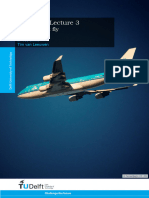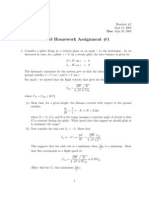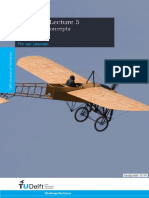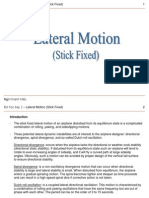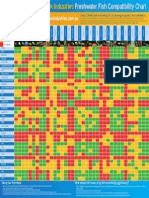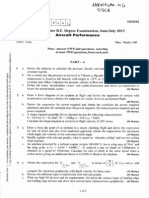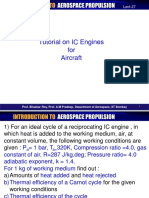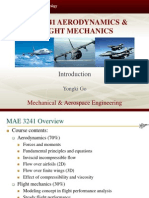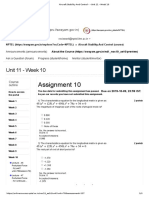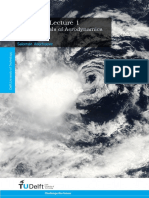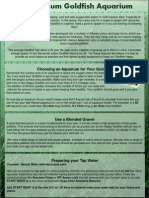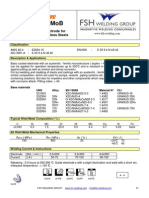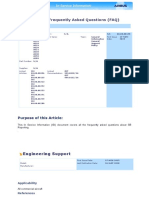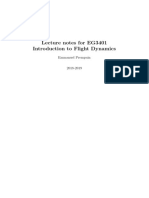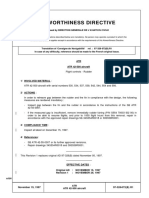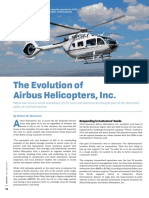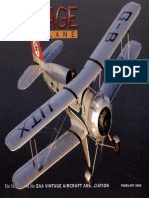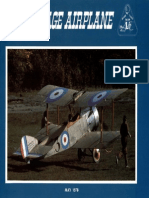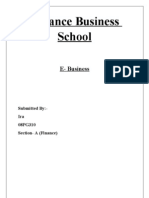As
As
Uploaded by
Gogo PCopyright:
Available Formats
As
As
Uploaded by
Gogo POriginal Description:
Original Title
Copyright
Available Formats
Share this document
Did you find this document useful?
Is this content inappropriate?
Copyright:
Available Formats
As
As
Uploaded by
Gogo PCopyright:
Available Formats
Exercises Lecture 6
Stability & Control
Prof. dr. ir. Jacco Hoekstra Tim van Leeuwen
Delft University of Technology
A. Sifre - CC - BY - NC - ND
AE1110x - Introduction to Aeronautical Engineering
Exercise 1
According to who was the issue of stability the nal hurdle to overcome before ight could take place? A) B) C) D) Samuel Langley Theodore von Karman The Wright brothers The Montgoler brothers
Exercise 2
Why do we see modern planes still having diculty with stability and control? A) B) C) D) The pilots may do manoeuvres the designers did not think of. It is impossible to make a perfectly controllable and stable aircraft. Control surfaces are very hard to design properly, due to complex aerodynamic eects. The control system of the aircraft does not match the pilots sensory and processing capabilities.
Exercise 3
What was the main dierence between the controls of the Wrights Flyer I and the controls of most European early planes? A) B) C) D) The Flyer had a horizontal tail in the front, rather than at the back The Flyer had larger ailerons The Flyer had a smaller vertical tail The Flyer was less stable than European planes
Exercise 4
Below you see a picture of a Condor Boeing 767. Three of its control surfaces have been highlighted in a yellow triangle, a green rectangle and a pink circle.
Figure 1: A Condor aircraft, with control surfaces highlighted. Image courtesy of Aero Icarus, CC - BY - SA 1) What is the name of the control surface in the yellow triangle? 2) What is the name of the control surface in the green rectangle? 3) What is the name of the control surface in the pink circle?
Exercises Lecture 6 - Stability & Control
AE1110x - Introduction to Aeronautical Engineering
Exercise 5
Early aircraft used wing warping to bank, modern aircraft use ailerons. Why dont modern aircraft use wing warping? A) B) C) D) Banking using ailerons is more aerodynamically ecient Banking using ailerons allows for faster banking Modern aluminium wings are not capable of warping Ailerons are easier to control than wing warping mechanisms
Exercise 6
A pilot wants to bank his aircraft to the left. What will he do?
Figure 2: A Delta aircraft banking to the left. Image courtesy of Pieter van Marion, CC - BY - SA A) B) C) D) E) F) Push the control column away Pull the control column towards him Turn the control column clockwise Turn the control column counter-clockwise Push his right pedal Push his left pedal
Exercise 7
Modern aircraft usually have two sets of ailerons: one inboard aileron (close to the fuselage) and one outboard aileron (further up the wing). Why is this?
Figure 3: A set of double ailerons. Image courtesy of Nelson Cunnington, CC - BY - NC - ND 2 Exercises Lecture 6 - Stability & Control
AE1110x - Introduction to Aeronautical Engineering
A) B) C) D)
The outboard ailerons serve as a backup, to still achieve banking during for example gusts. Two sets of ailerons allow for redundancy: if one set fails the other set is used. The two sets of ailerons are used for dierent weather conditions. The two sets of ailerons are used for dierent ight speeds.
Exercise 8
For most conventional aircraft the line of action of the engine thrust is situated below the aircraft centre of gravity. This means that in case the engine thrust is altered, the pitching moment of the aircraft will be aected. To prevent the aircraft from pitching, the elevator can be deected a bit. Suppose the pilot of a conventional aircraft decides to increase the thrust of this aircraft, but wants to keep the pitch angle (and angle of attack) the same. What kind of elevator deection should he give to prevent his aircraft from pitching: a positive or negative one?
Exercise 9
Suppose an aircraft ies under an angle of attack of 5.6 degrees, and at a pitch angle of 8 degrees. Determine the climb angle of this aircraft, in degrees.
Figure 4: A British Airways Boeing 747. Image courtesy of Aero Icarus, CC - BY - SA
Exercise 10
Suppose a passenger aircraft ies with a course of 80 degrees and a heading of 84 degrees (both according to the compass). Determine the angle of sideslip it then experiences.
Exercise 11
Below you see a picture of a deected rudder. If the pilot would deect his rudder in this way during ight, what yaw angle will the aircraft get: a positive or a negative one?
Figure 5: A British Airways Boeing 747. Image courtesy of Mark Jones Jr, CC - BY Exercises Lecture 6 - Stability & Control 3
AE1110x - Introduction to Aeronautical Engineering
Exercise 12
As an aircraft ies across the globe, it must continuously pitch (with respect to an inertial frame of reference) to keep following the curvature of the Earth. From that point of view, what must the sign of this continuous (though extremely small) pitch rate be?
Exercise 13
Below you see a picture of a mass m attached to a spring. By what kind of stability is this system characterised?
Figure 6: A mass-spring system. A) Positive static stability B) Neutral static stability C) Negative static stability
Exercise 14
Consider a statically stable aircraft in the yaw direction. What direction will the aircraft straight away yaw to after the pilot has pushed his left foot pedal? A) The positive yaw direction B) The negative yaw direction
Exercise 15
In a car, you basically have two controls in the forward direction: the throttle and the brake pedal. Consider this type of control system. How many integrators are there in this control system?
Exercise 16
Which of the following actions is not a way to make an aircraft (more) longitudinally statically stable? A) B) C) D) Increasing the horizontal tail surface area Increasing the wing lift coecient gradient Placing the horizontal tail out of the downwash of the wing Decreasing the wing surface area
Exercises Lecture 6 - Stability & Control
AE1110x - Introduction to Aeronautical Engineering
Exercise 17
Below you see a gure of a ying wing, so an aircraft without a tail. Its centre of gravity is situated behind the aerodynamic centre of the wing, with lcg = 0.05c .
Figure 7: Image courtesy of indianadinos, CC - BY - NC - SA
If you are given that the wing ies with CL = 0.8 and given that Cm = 0.02 , determine the moment coecient of the moment around the aerodynamic centre.
Exercise 18
Again consider the ying wing of the problem above. Is this ying wing longitudinally statically stable?
Exercise 19
Below you see a picture of an Airbus A340-600.
Figure 8: Image courtesy of indianadinos, CC - BY - NC - SA
Of this aircraft you are given the following parameters: lw ing = 34.9m ltail = 67.8m S = 437m2 SH = 93m2 c = 8.35m a = 4.8/rad at = 5.2/rad Furthermore we will assume that the downwash angle is equal to 10% of the angle of attack of the wing. Given that the centre of gravity of this A340-600 is situated 39.2 metres from the nose, nd the static margin (in metres) of this A340. Exercises Lecture 6 - Stability & Control 5
AE1110x - Introduction to Aeronautical Engineering
Exercise 20
In the picture below you see a King Air 200, an aircraft with a so-called T-tail. One of the primary reasons of placing the tail higher up is to keep the tail out of the wake and downwash of the wing.
Figure 9: Image courtesy of Mark Jones Jr., CC - BY For this aircraft, we will in this exercise investigate the required position of the centre of gravity to guarantee static, longitudinal stability. The rst step in this analysis is to set up the moment equation around the centre of gravity of this aircraft. 1) Derive the moment equation around the centre of gravity of this King Air 200, as a function of the total lift L, the tail lift LH , the centre of gravity distance lcg , the tail arm lH and the aerodynamic centre moment Mac . Tips: Use the sign convention "Pitch up = positive" and take a positive moment in the aerodynamic centre. 2) Non-dimensionalise the equation just derived and give the result below. You are allowed to use the quantities c , lcg , lH , S , SH , Cmac , CL and CLH . Tip: Dont introduce the tail volume yet. 3) Derive this equation with respect to the angle of attack and give your result for Cm . You are allowed to use the quantities c , lcg , VH (the tail volume), a (the wing lift coecient gradient) and at (the tail lift coecient gradient). 4) What is the requirement on the position of the centre of gravity? You are allowed to use the quantities c , lcg , VH (the tail volume), a (the wing lift coecient gradient) and at (the tail lift coecient gradient).
Exercises Lecture 6 - Stability & Control
You might also like
- Assignment TemplateDocument18 pagesAssignment Templatefaisal khan0% (1)
- Assignment A 3Document6 pagesAssignment A 3amir yousefiNo ratings yet
- TestModuleA AnsDocument11 pagesTestModuleA AnsMateus Pedro100% (2)
- MCQ On Uprt: Answer: A. (Section 2.4.1)Document2 pagesMCQ On Uprt: Answer: A. (Section 2.4.1)Nil100% (1)
- A320 NeoDocument1 pageA320 NeoLawrence H100% (1)
- MIT Aircraft Stability and Control 02 - AssignmentsDocument14 pagesMIT Aircraft Stability and Control 02 - AssignmentsAndré Da Luz MoreiraNo ratings yet
- Assignment 5Document7 pagesAssignment 5José A. Montiel Quirós0% (1)
- Steady Aircraft Flight and PerformanceFrom EverandSteady Aircraft Flight and PerformanceRating: 5 out of 5 stars5/5 (2)
- Past Exam Ae451Document7 pagesPast Exam Ae451Siyar JoyendaNo ratings yet
- AER 504 Aerodynamics: Ryerson University Department of Aerospace EngineeringDocument8 pagesAER 504 Aerodynamics: Ryerson University Department of Aerospace EngineeringbatmanbittuNo ratings yet
- Aer416, Flight Mechanics SolutionsDocument2 pagesAer416, Flight Mechanics SolutionsUrshia Likes CookiesNo ratings yet
- Mae 3241: Aerodynamics and Flight Mechanics: Finite Wings: General Lift Distribution SummaryDocument21 pagesMae 3241: Aerodynamics and Flight Mechanics: Finite Wings: General Lift Distribution SummaryCris M Rodríguez BNo ratings yet
- Bài 5 - Lateral Motion (Stick Fixed) (2008)Document12 pagesBài 5 - Lateral Motion (Stick Fixed) (2008)neiht_ksNo ratings yet
- AnsDocument4 pagesAnsDinesh YadavNo ratings yet
- Prandtl Glauert and Ackert's Rule PDFDocument7 pagesPrandtl Glauert and Ackert's Rule PDFashwaNo ratings yet
- Flight Dynamics ProjectDocument26 pagesFlight Dynamics ProjectShatha SivamNo ratings yet
- Freshwater Fish Compatibility ChartDocument1 pageFreshwater Fish Compatibility ChartGogo PNo ratings yet
- TFE 731 Chap 76Document42 pagesTFE 731 Chap 76Egor85100% (4)
- King Air in IndiaDocument10 pagesKing Air in Indiavikash_kumar_thakur0% (1)
- Assignment 7Document7 pagesAssignment 7José A. Montiel QuirósNo ratings yet
- Exercises Lecture 3 - Answers: Climbing and Descending FlightDocument9 pagesExercises Lecture 3 - Answers: Climbing and Descending FlightBaptiste100% (1)
- TestModuleBAns PDFDocument5 pagesTestModuleBAns PDFMateus Pedro100% (2)
- Aircraft Performance-2 PDFDocument6 pagesAircraft Performance-2 PDFkkkrajaNo ratings yet
- Assignment 4Document4 pagesAssignment 4José A. Montiel QuirósNo ratings yet
- Calculating Surface Integrals in FLUENTDocument1 pageCalculating Surface Integrals in FLUENTvyakshiNo ratings yet
- Aircraft Design Project - Phase 2Document64 pagesAircraft Design Project - Phase 2Sultan Badhusha100% (1)
- Aircraft PerformanceDocument2 pagesAircraft PerformanceAishwarya Ravi0% (1)
- Delft - AerodynamicsDocument14 pagesDelft - AerodynamicsmegatherionNo ratings yet
- A: A Nozzle Is Said To Be Operating in Under-Expanded Condition If Exit Pressure Is Higher Than TheDocument3 pagesA: A Nozzle Is Said To Be Operating in Under-Expanded Condition If Exit Pressure Is Higher Than TheBalaji HimakarNo ratings yet
- Thin Aerofoil Theory NotesDocument25 pagesThin Aerofoil Theory Notessasiaero100% (1)
- Exercises: Flight Dynamics-I Prof. E.G. Tulapurkara Chapter-5Document1 pageExercises: Flight Dynamics-I Prof. E.G. Tulapurkara Chapter-5Chegrani AhmedNo ratings yet
- Aerodynamics Midterm SolutionDocument9 pagesAerodynamics Midterm SolutionStetson TurnerNo ratings yet
- Question Bank AerodynamicDocument7 pagesQuestion Bank AerodynamicAjay DeshmukhNo ratings yet
- AE2030 - Fatigue and FractureDocument1 pageAE2030 - Fatigue and FractureArun Raja K K100% (1)
- Elements of Airplane Performance: ME 4021: Flight Dynamics Fazle Rabbi SirDocument42 pagesElements of Airplane Performance: ME 4021: Flight Dynamics Fazle Rabbi SirRafiqul IslamNo ratings yet
- Rr312102 Aircraft PerformanceDocument8 pagesRr312102 Aircraft PerformanceSrinivasa Rao GNo ratings yet
- Lec27 Problem Solution PDFDocument22 pagesLec27 Problem Solution PDFmaya singhNo ratings yet
- Conceptual DesignDocument28 pagesConceptual DesignDaniel JaimiNo ratings yet
- Assignment 01: Unit 2 - Week 1Document3 pagesAssignment 01: Unit 2 - Week 1Parkash SinghNo ratings yet
- Ae 430 3 PDFDocument14 pagesAe 430 3 PDFcrimelife6100% (1)
- Design ConstructionDocument157 pagesDesign ConstructionfarahNo ratings yet
- 08 2 Moment of Inertia PDFDocument14 pages08 2 Moment of Inertia PDFReddyvari VenugopalNo ratings yet
- Rocket Propulsion Solved ProblemsDocument15 pagesRocket Propulsion Solved Problemsmase dzNo ratings yet
- Experimental Aerodyamics SyllabusDocument1 pageExperimental Aerodyamics Syllabustjpk100% (1)
- QB - MA3452 - VC&CF-semesterDocument10 pagesQB - MA3452 - VC&CF-semesterguys4929No ratings yet
- MAE3241 Ch01 IntroductionDocument20 pagesMAE3241 Ch01 Introductionmblaskovich2010No ratings yet
- Assignment 10: Unit 11 - Week 10Document3 pagesAssignment 10: Unit 11 - Week 10aeroacademicNo ratings yet
- Rana Anurag Aeromodelling Lab Final Report 08Document18 pagesRana Anurag Aeromodelling Lab Final Report 08Anurag RanaNo ratings yet
- Ae 1254 - Aircraft Structures - 1: Two Mark Question & AnswersDocument21 pagesAe 1254 - Aircraft Structures - 1: Two Mark Question & AnswersArunraj KasiNo ratings yet
- Math Dictionary For EASA Module 1 StudyDocument6 pagesMath Dictionary For EASA Module 1 StudySteven J. SelcukNo ratings yet
- Lifting Line TheoryDocument19 pagesLifting Line TheorymgskumarNo ratings yet
- 7 TH Sem AdpDocument56 pages7 TH Sem AdpJackson JackNo ratings yet
- Stability Augmentation SystemsDocument4 pagesStability Augmentation SystemsSuraj ChaurasiyaNo ratings yet
- HW 7Document3 pagesHW 7RaulNo ratings yet
- Thin AirfoilDocument25 pagesThin AirfoilmgskumarNo ratings yet
- Isidoro Martinez - Aircraft Propulsion PDFDocument41 pagesIsidoro Martinez - Aircraft Propulsion PDFjoereisNo ratings yet
- Assignment B 1Document4 pagesAssignment B 1José A. Montiel QuirósNo ratings yet
- Xfoil Mdes TutorialDocument1 pageXfoil Mdes TutorialOzichukwu OsakweNo ratings yet
- A Effect of Elevator Deflection On Lift Coefficient IncrementDocument17 pagesA Effect of Elevator Deflection On Lift Coefficient IncrementIJMERNo ratings yet
- Unit-Iv Notes Faculty Name: R.Jini Raj Class: B.E Aeronautical Subject Code: Ae8604 Semester: Vi Subject Name: Aircraft DesignDocument28 pagesUnit-Iv Notes Faculty Name: R.Jini Raj Class: B.E Aeronautical Subject Code: Ae8604 Semester: Vi Subject Name: Aircraft DesignTHE BOISNo ratings yet
- Exercises Lecture 3: How Aircraft FlyDocument6 pagesExercises Lecture 3: How Aircraft FlyJosé A. Montiel QuirósNo ratings yet
- Aaeb13 PTDocument343 pagesAaeb13 PTMeghana Sai DNo ratings yet
- 01 045 FDSDocument10 pages01 045 FDSJaveria NaseemNo ratings yet
- Attempt All Questions. For Full Credit, Write Dimensions in The Answers. - Maintain Academic IntegrityDocument5 pagesAttempt All Questions. For Full Credit, Write Dimensions in The Answers. - Maintain Academic IntegrityFabNo ratings yet
- Mission Concepts and TimelinesDocument8 pagesMission Concepts and TimelinesGogo PNo ratings yet
- AswDocument40 pagesAswGogo P100% (2)
- Black Moor GoldfishDocument11 pagesBlack Moor GoldfishGogo PNo ratings yet
- Goldfish: Starting Out WithDocument16 pagesGoldfish: Starting Out WithGogo PNo ratings yet
- NCycleDocument2 pagesNCycleGogo PNo ratings yet
- Goldfish VarietiesDocument5 pagesGoldfish VarietiesGogo PNo ratings yet
- Optimum GoldfishDocument5 pagesOptimum GoldfishGogo PNo ratings yet
- Fizika 1 Reklama 2011Document1,030 pagesFizika 1 Reklama 2011Gogo PNo ratings yet
- Elezović - Linearna AlgebraDocument104 pagesElezović - Linearna AlgebraGogo P100% (1)
- Goldfish: Carassius AuratusDocument2 pagesGoldfish: Carassius AuratusGogo PNo ratings yet
- 10 InterfaceDocument11 pages10 InterfaceGogo PNo ratings yet
- Selectarc Selectarc Selectarc Selectarc: Inox 2509mobDocument1 pageSelectarc Selectarc Selectarc Selectarc: Inox 2509mobGogo PNo ratings yet
- 78 PDFDocument1 page78 PDFGogo PNo ratings yet
- Supranox Rs 347: MMA Electrodes Stainless and Heat Resistant SteelsDocument1 pageSupranox Rs 347: MMA Electrodes Stainless and Heat Resistant SteelsGogo PNo ratings yet
- Passive and Active VoiceDocument4 pagesPassive and Active VoiceGogo PNo ratings yet
- Passive Voice. Volunteer Exercise. Change From Active To PassiveDocument2 pagesPassive Voice. Volunteer Exercise. Change From Active To PassiveGogo PNo ratings yet
- 2.61 Internal Combustion Engines: Mit OpencoursewareDocument2 pages2.61 Internal Combustion Engines: Mit OpencoursewareGogo PNo ratings yet
- 2.61 Internal Combustion Engines: Mit OpencoursewareDocument2 pages2.61 Internal Combustion Engines: Mit OpencoursewareGogo PNo ratings yet
- PPL Lesson 5 OverviewDocument3 pagesPPL Lesson 5 OverviewShannon-claire McauleyNo ratings yet
- 00.00.00179 - SB Reporting Frequently Asked Questions (FAQ)Document10 pages00.00.00179 - SB Reporting Frequently Asked Questions (FAQ)Manish ShAhNo ratings yet
- Rules, The Battle For Stalingrad, Turning Point, November-December 1942Document8 pagesRules, The Battle For Stalingrad, Turning Point, November-December 1942Christian RNNo ratings yet
- A320 Normal Procedures - ListanoDocument6 pagesA320 Normal Procedures - ListanoAngelo ListanoNo ratings yet
- UqzogranukyzkdyzujnrDocument201 pagesUqzogranukyzkdyzujnrtempuserlol4242No ratings yet
- Lecture Notes For EG3401 Introduction To Flight Dynamics: Emmanuel PrempainDocument79 pagesLecture Notes For EG3401 Introduction To Flight Dynamics: Emmanuel PrempainAnonymous CFWoaKhNo ratings yet
- RNRDocument21 pagesRNRabi_5dec94No ratings yet
- A330-300 HGW: RR TRENT EngineDocument79 pagesA330-300 HGW: RR TRENT EngineArvin DavidNo ratings yet
- Airworthiness Directive: ATR ATR 42-500 AircraftDocument1 pageAirworthiness Directive: ATR ATR 42-500 AircraftlakshmimurugesanNo ratings yet
- Uh-60 Capabilities 2Document6 pagesUh-60 Capabilities 2German PinerosNo ratings yet
- Civil Aviation Chapter 1 and 2Document43 pagesCivil Aviation Chapter 1 and 2Anjila Bhatta0% (1)
- Airbus A340 600Document107 pagesAirbus A340 600Fahad Ali100% (2)
- US Airways Flight 1549 - WikipediaDocument14 pagesUS Airways Flight 1549 - WikipediaPero KvržicaNo ratings yet
- The Evolution of Airbus Helicopters, IncDocument4 pagesThe Evolution of Airbus Helicopters, Incluc-Jean NiergraNo ratings yet
- Vintage Airplane - Feb 2006Document44 pagesVintage Airplane - Feb 2006Aviation/Space History LibraryNo ratings yet
- A320 LimitationsDocument19 pagesA320 LimitationsRodolfoNo ratings yet
- Vintage Airplane - May 1978Document28 pagesVintage Airplane - May 1978Aviation/Space History Library100% (1)
- Flying - April 2016Document92 pagesFlying - April 2016Robert Olaff Bernard KislingerNo ratings yet
- CL605 QRH Vol-1Document235 pagesCL605 QRH Vol-1Alejandro Martínez BaezaNo ratings yet
- Normal Procedures 737-NgDocument101 pagesNormal Procedures 737-NgAllan Mucken100% (2)
- Learning Statement Reference GuideDocument24 pagesLearning Statement Reference GuideMessala YoveraNo ratings yet
- Dgca Module 12 Part 01Document21 pagesDgca Module 12 Part 01ahmedharfoushNo ratings yet
- Stealth TechnologyDocument6 pagesStealth TechnologyGaurav KumarNo ratings yet
- Enbrenfl PDF 1610475388Document8 pagesEnbrenfl PDF 1610475388Emerald GrNo ratings yet
- Grob Aircraft Ag Lettenbachstrasse 9 86874 Tussenhausen-Mattsies Germany Phone: +49 (0) 8268 998 - 0 E-Mail ContactDocument2 pagesGrob Aircraft Ag Lettenbachstrasse 9 86874 Tussenhausen-Mattsies Germany Phone: +49 (0) 8268 998 - 0 E-Mail Contactdawud MohammedNo ratings yet
- Silent Knight RadarDocument9 pagesSilent Knight RadarThinkDefence100% (3)
- Turbine Engine Design ConstructionDocument63 pagesTurbine Engine Design ConstructionJerichoNo ratings yet

